This post was originally created to honour the Day of the Dead, however, do to unforeseen circumstances has been posted WAY late. My bad and spanx for the forgiveness.
In honour of the Day of the Dead I decided to create a list of some of the most fascinating resting places on Earth. Each cemetery on the list has been chosen for its rich folklore, architecture, history and in some cases because they are just down right creepy. There are MANY other amazing cemeteries that I have not included in this list, so many in fact, that next year I should be able to complete another list of 13, but these particular 13 surpassed by a long shot. They are listed from 13-1, with #1 being a place I am not sure I could ever visit at night, but would love the bragging rights of being able to say I did. Cheers!
Location: Nouadhibou, West Africa
History: Located outside the 2nd largest city in Mauritania, the Bay of Nouadhibou is reportedly home to the worlds largest ship graveyard. The city of Nouadhibou has a population of approximately 90,000 and serves as the trading center for meteorites found in the Saharan Desert. But one of its main attractions for photographers and tourists is the Bay, where for nearly a hundred years ships have been deserted. The local officials were paid to let ships rust to death in the waters off the coast, and for an area that is as economically deprived as Mauritania, the income was a welcome relief. Proper disposal of ships is an expensive procedure, so it is unsurprising that shipping companies were happy to cut a deal and sell their vessels to the Mauritanian locals.
Famous Occupants: Since there is no formal acknowledgement that the ships are being “harboured” there isn’t an official log on which vessels have been laid to rest.
 Selected Because: So this isn’t a consecrated burial ground filled with human remains and the like…. It doesn’t matter, the absolute and complete creepiness of sea vessels dead and gone, is huge. Each ship seeming to have a soul of its own, these waters are said to hold the secrets of nations. Folklore whispers that the laughter of passengers long since passed can be heard on the wind and the screams of the less fortunate souls who lost their lives in wars or worse, compete with the groan of rusting and slowly capsizing metal. Although certainly not the scariest graveyard on the list, it is definitely an eerie sight to see the warriors of the seas, rusted and broken shells of their former glory.
Selected Because: So this isn’t a consecrated burial ground filled with human remains and the like…. It doesn’t matter, the absolute and complete creepiness of sea vessels dead and gone, is huge. Each ship seeming to have a soul of its own, these waters are said to hold the secrets of nations. Folklore whispers that the laughter of passengers long since passed can be heard on the wind and the screams of the less fortunate souls who lost their lives in wars or worse, compete with the groan of rusting and slowly capsizing metal. Although certainly not the scariest graveyard on the list, it is definitely an eerie sight to see the warriors of the seas, rusted and broken shells of their former glory.
Location: Luxor, Egypt
History: The Valley of the Kings is a basin in Egypt where, for a period of nearly 500 years from the 16th to the 11th century B.C., tombs were constructed for the Pharaohs and powerful nobles of the New Kingdom. The valley stands on the west bank of the Nile opposite Thebes (modern Luxor), within the heart of the Theban Necropolis. The wadi consists of two valleys, East and West. To date, the valley is known to contain 63 tombs and chambers (ranging in size from a single pit to a complex tomb with over 120 chambers), and was the principal burial-place of the major royal figures, together with a number of prominent nobles. The royal tombs are decorated with scenes from Egyptian mythology and leave clues to the beliefs and funerary rituals of the period. Almost all of the tombs seem to have been opened and robbed in antiquity, but they still give an idea of the opulence and power of the rulers of the time. This area has been a source of archeological and Egyptological exploration since the end of the 18th century, and its tombs and burials continue to stimulate research and interest.
Famous Occupants: Ramses I, Seti I, Amenhotep II, King Tutankhamen
 Selected Because: Perhaps the valley is best known for its “Curse of the Pharaoh”. The curse of the pharaoh refers to the belief that any person who disturbs the mummy of an Ancient Egyptian pharaoh is placed under a curse. There are occasional instances of curses appearing inside of the facade of a tomb. Though there have been stories of curses going back to the 19th century, they multiplied in the aftermath of Howard Carter’s discovery of the tomb of Tutankhamen. A famous Egyptologist James Breasted, who worked with Carter on the Tut dig, reported that shortly before the tomb was to be opened Carter sent a messenger to his residence to collect some documentation. Rumour was that as the messenger approached the house he heard “a faint cry” and upon entering found a cobra in the bottom of the birdcage having swallowed the canary. Arthur Weigall, a previous Inspector-General of Antiquities to the Egyptian Government, reported that this was interpreted as Carter’s house being broken into by the Royal Cobra (the symbol and safeguard of the Egyptian royals) on the very day that Tut’s tomb was being opened. An account of the incident was reported by the New York Times on the 22nd of December 1922. The first of the “mysterious deaths” was that of Lord Carnarvon. He had been bitten by a mosquito and later slashed the bite accidentally while shaving. It became infected and blood poisoning resulted. A media frenzy followed with reports that a curse had been found in the King’s tomb. Arthur Conan Doyle, the creator of Sherlock Holmes, suggested at the time that Lord Carnarvon’s death had been caused by “elementals” created by Tut’s priests, to guard the royal tomb and this further fuelled the media interest. Dr. Derry who carried out the first autopsy on the body of Tut found a healed lesion on the left cheek, but as Carnarvon had been buried six months previously, it was not possible to determine if the location of the wound on the King corresponded with the location of the fatal mosquito bite on Carnarvon. The tomb was opened on November 29, 1922. Lord Carnarvon died on April 5, 1923. George J. Gould died on May 16 1923 (he developed a fever after visiting the tomb), Howard Carter died March 2, 1939, of lymphoma. Those who believe in the curse suggest an additional 11 people who were present at the time of the opening of the tomb, have died of mysterious causes, before their time.
Selected Because: Perhaps the valley is best known for its “Curse of the Pharaoh”. The curse of the pharaoh refers to the belief that any person who disturbs the mummy of an Ancient Egyptian pharaoh is placed under a curse. There are occasional instances of curses appearing inside of the facade of a tomb. Though there have been stories of curses going back to the 19th century, they multiplied in the aftermath of Howard Carter’s discovery of the tomb of Tutankhamen. A famous Egyptologist James Breasted, who worked with Carter on the Tut dig, reported that shortly before the tomb was to be opened Carter sent a messenger to his residence to collect some documentation. Rumour was that as the messenger approached the house he heard “a faint cry” and upon entering found a cobra in the bottom of the birdcage having swallowed the canary. Arthur Weigall, a previous Inspector-General of Antiquities to the Egyptian Government, reported that this was interpreted as Carter’s house being broken into by the Royal Cobra (the symbol and safeguard of the Egyptian royals) on the very day that Tut’s tomb was being opened. An account of the incident was reported by the New York Times on the 22nd of December 1922. The first of the “mysterious deaths” was that of Lord Carnarvon. He had been bitten by a mosquito and later slashed the bite accidentally while shaving. It became infected and blood poisoning resulted. A media frenzy followed with reports that a curse had been found in the King’s tomb. Arthur Conan Doyle, the creator of Sherlock Holmes, suggested at the time that Lord Carnarvon’s death had been caused by “elementals” created by Tut’s priests, to guard the royal tomb and this further fuelled the media interest. Dr. Derry who carried out the first autopsy on the body of Tut found a healed lesion on the left cheek, but as Carnarvon had been buried six months previously, it was not possible to determine if the location of the wound on the King corresponded with the location of the fatal mosquito bite on Carnarvon. The tomb was opened on November 29, 1922. Lord Carnarvon died on April 5, 1923. George J. Gould died on May 16 1923 (he developed a fever after visiting the tomb), Howard Carter died March 2, 1939, of lymphoma. Those who believe in the curse suggest an additional 11 people who were present at the time of the opening of the tomb, have died of mysterious causes, before their time.
11. Brookwood Cemetery
History: In Surrey woodland, right on the Hampshire border of the training grounds for the British army, stands a cemetery of family tombs, gravestones and memorials from Victorian London and of soldiers tragically killed in wars gone by. The Necropolis was founded in 1862, but the land on which it sits goes back further still. It is situated directly next to the Brookwood railway station, as it was used to house the dead of an ever-growing London. As the population of the city in the mid 1850’s was growing beyond the control of authorities, Brookwood was built to take the strain away from London’s already overflowing cemeteries. In the daylight and on hazy summer days, Brookwood Necropolis is a place of beauty, stillness and tranquility, with its huge redwood trees, never-ending pathways, and rows as far as the eye can see of white crosses of the war dead. It stands out as one of the world’s most fascinating and inspiring places of rest. Even though many of the dead are victims of past wars, the cemetery is a mixed faith cemetery of Christian, Muslim and Zoroastrian beliefs, so it stands as a monument of hope to many who wish for a more peaceful world.
Famous Occupants: Margaret the Duchess of Argyll, John Singer Sargent, Edith Thompson
 Selected Because: Many strange sounds can be heard coming from in and around the tombs, and patches of forest. Some would suggest it is nothing more than rats and birds, while others would suggest something a lot more sinister and spectral in nature. Visual sightings have been reported, such as green and white shapes, mists hovering over graves and floating across pathways, weaving in and out of trees. Many visitors report feelings of anxiety, sadness and nausea around certain parts of the cemetery. The path that the train track was on still runs through the grounds, and it is said that if you walk it, you can hear the sounds of women and babies crying. Occasionally, the sound of a train has also been heard.
Selected Because: Many strange sounds can be heard coming from in and around the tombs, and patches of forest. Some would suggest it is nothing more than rats and birds, while others would suggest something a lot more sinister and spectral in nature. Visual sightings have been reported, such as green and white shapes, mists hovering over graves and floating across pathways, weaving in and out of trees. Many visitors report feelings of anxiety, sadness and nausea around certain parts of the cemetery. The path that the train track was on still runs through the grounds, and it is said that if you walk it, you can hear the sounds of women and babies crying. Occasionally, the sound of a train has also been heard.
Location: Paris, France
History: Pére-Lachaise is one of the world’s most visited cemeteries, attracting hundreds of thousands of visitors a year to the graves of those who have enhanced French life over the last 200 years. The cemetery was established by Napoleon in 1804. Cemeteries had been banned inside Paris in 1786 after the closure of the Cimetiére des Innocents on the fringe of the Lés Halles food market, on the grounds that it presented a health hazard. At the time of its opening, the grounds were considered to be located too far from the city and attracted very few funerals. Consequently, the administrators devised a marketing strategy and with great fanfare organized the transfer of the remains of La Fontaine and Moliere in 1804. Then in another great spectacle in 1817, the purported remains of Pierre Abelaird and Héloise were also transferred to the cemetery, with their monument’s canopy made from fragments of the abbey of Norgent-sur-Siene (by tradition lovers or lovelorn singles, leave letters at their crypt in tribute to the couple or in hopes of finding true love). This strategy achieved its desired effect and people began clamouring to be buried among the famous citizens. Records show that in the last few years Pére-Lachaise went from containing a few dozen permanent residents to more than 33,000. Today there are over 300,000 bodies buried there, and many more in the columbium which holds the remains of those who had requested cremation.
Famous Occupants: Frederic Chópin, Giaacchio Rossini, Jim Morrison
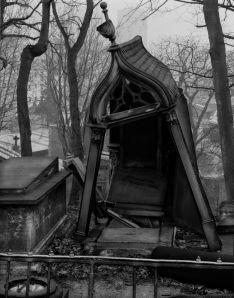 Selected Because: The Communists Wall is located in the cemetery. This is the site where 147 Communards, the last defenders of the workers district of Belleville, were shot on May 28, 1871. Adolphe Theirs, widely blamed for the massacres of “Bloody Week”, is an ironic resident of the cemetery. His tomb has occasionally been the subject of vandalism. Many believe his ghost is forever at unrest and often tugs on the clothes of those who pass near his tomb begging them not to desecrate it. The ghost of Jim Morrison is said to often be photographed in and around his grave. Many parts of Pére-Lachaise have been defaced with arrows reportedly indicating the direction of “Jim”, though even these defacements have in many cases been defaced themselves, resulting in arrows that point in two directions. Morrison’s grave is one of the city’s most visited attractions. Morrison’s father, placed a flat stone on the grave in 1990 after the grave had been vandalized and robbed on numerous occasions. Now a the simple stone reads “KATA TON ALMONA EAYTOY”, literally meaning “according to his own daimon”.
Selected Because: The Communists Wall is located in the cemetery. This is the site where 147 Communards, the last defenders of the workers district of Belleville, were shot on May 28, 1871. Adolphe Theirs, widely blamed for the massacres of “Bloody Week”, is an ironic resident of the cemetery. His tomb has occasionally been the subject of vandalism. Many believe his ghost is forever at unrest and often tugs on the clothes of those who pass near his tomb begging them not to desecrate it. The ghost of Jim Morrison is said to often be photographed in and around his grave. Many parts of Pére-Lachaise have been defaced with arrows reportedly indicating the direction of “Jim”, though even these defacements have in many cases been defaced themselves, resulting in arrows that point in two directions. Morrison’s grave is one of the city’s most visited attractions. Morrison’s father, placed a flat stone on the grave in 1990 after the grave had been vandalized and robbed on numerous occasions. Now a the simple stone reads “KATA TON ALMONA EAYTOY”, literally meaning “according to his own daimon”.
Location: Paris, France
History: In Roman times, Paris buried its dead on the outskirts of the city. This changed with the rise of Christianity and its practice of burying its faithful in consecrated ground in and around its churches. By the 10th century, the city had expanded and there were many parish cemeteries within city limits, even in central locations. When Paris’s population began to rise rapidly in the following centuries, some of these cemeteries became overcrowded and because of their location in populated areas, they were unable to expand. Soon, only the most wealthy could afford church burials, which lead to the opening of a common burial ground in the 12th century. Initially dependent upon the St. Opportune Church, this cemetery near Paris’s central Lés Halles district, was renamed Saints Innocents Cemetery under its own church and parish. The common practice for burying the less-wealthy at the time, was mass inhumation. Once an excavation in one section of the cemetery was full, it would be covered over and another opened. Few of the dead buried in this way had the privilege of a coffin, often the casket used for a burial ceremony would be re-used for the next. By the 17th century the sanitary conditions around Saints Innocents were unbearable. As it was one of Paris’s most sought after cemeteries and a large source of revenue for the parish and church, the clergy had continued burials there, even with the grounds overflowing. A series of ineffective decrees limiting the use of the cemetery did little to remedy the situation, and it wasn’t until the late 18th century that the decision was made to create three new large-scale suburban burial grounds on the outskirts of the city and to condemn all existing parish cemeteries within the city limits. Part of the reason nothing was done about Paris’s untenable burial practices was finding a location ideal for disposing of the dead exhumed from the parish cemeteries. The government had been searching for and consolidating long abandoned stone quarries in and around the capital since 1777, and it was the Police Lieutenant General overseeing the renovations, who first had the idea to use empty underground tunnels on the outskirts of the capital to this end. His successor, chose a place to the south of Paris’s city gate, and the exhumation and transfer of all of Paris’s dead began in 1786 taking until 1788 to complete.
Famous Occupants: None
 Selected Because: A million visitors a year are said to walk the dank corridors to stare at the bones and gaze fixedly into the empty eye sockets of the long dead. Many of these same visitors and some of their guides have encountered more then just the silence in the catacombs, they have faced ghostly inhabitants that roam the empty passageways and mutely follow the tour groups around. Ghost photos and eerie feelings have often been reported by many of the visitors to the location. Ghosts are often said to be “felt” more than witnessed. Many have reported that they have been grabbed or touched. Several report seeing a group of shadows in one area of the catacombs, as the living walk along the dead following in compete silence. To some, the experience is completely overwhelming and tours have been cut short by the growing sense of unease. The Catacombs are a veritable rabbit’s warren, and though many boldly enter without a guide, to do so puts one at risk of being lost there forever. There are rumours of individuals wandering into the catacombs for a laugh and have never been seen from again.
Selected Because: A million visitors a year are said to walk the dank corridors to stare at the bones and gaze fixedly into the empty eye sockets of the long dead. Many of these same visitors and some of their guides have encountered more then just the silence in the catacombs, they have faced ghostly inhabitants that roam the empty passageways and mutely follow the tour groups around. Ghost photos and eerie feelings have often been reported by many of the visitors to the location. Ghosts are often said to be “felt” more than witnessed. Many have reported that they have been grabbed or touched. Several report seeing a group of shadows in one area of the catacombs, as the living walk along the dead following in compete silence. To some, the experience is completely overwhelming and tours have been cut short by the growing sense of unease. The Catacombs are a veritable rabbit’s warren, and though many boldly enter without a guide, to do so puts one at risk of being lost there forever. There are rumours of individuals wandering into the catacombs for a laugh and have never been seen from again.
Location: Prague, Czech Republic
History: One of the most impressive sites in Prague is the Old Jewish Cemetery in Josefov, the former Jewish Ghetto. The oldest tombstone, which marks the grave of the poet and scholar Avigdor Karo, dates from the year 1439. Burials took place in the cemetery until 1787.The Nazis made it a policy to destroy Jewish cemeteries, sometimes using the tombstones for target practice, however, Hitler ordered that this cemetery be left intact, since he was planning to build a Jewish museum in Prague after all the Jews in Europe had been exterminated, according to his diabolical plan. While there are only about 12,000 tombstones visible, it is estimated that more than 100,000 persons have been buried at the site, graves stacked 12 layers deep.
Famous Occupants: Avigdor Karo, Judah Loew ben Bezalel, David Oppenheim
 Selected Because: According to Jewish tradition, you are not to remove gravestones from their original resting places, so when the cemetery ran out of room and purchasing more land was not possible, extra layers of dirt were brought in and placed on top of old grave stones and new ones were placed on the new soil. This resulted in 12 layers of graves. The cemetery is also home to the man who supposedly created the Golem. A Golem is a Frankenstein’s monster type of creature, that was created by Rabbi Judah Loew to help protect the Jews of Prague, from persecution. According to legend, the Golem eventually got out of control and the Rabbi had to destroy it. Some claim to see the Golem roaming around the cemetery grounds and others claim to see the ghost of Rabbi Loew.
Selected Because: According to Jewish tradition, you are not to remove gravestones from their original resting places, so when the cemetery ran out of room and purchasing more land was not possible, extra layers of dirt were brought in and placed on top of old grave stones and new ones were placed on the new soil. This resulted in 12 layers of graves. The cemetery is also home to the man who supposedly created the Golem. A Golem is a Frankenstein’s monster type of creature, that was created by Rabbi Judah Loew to help protect the Jews of Prague, from persecution. According to legend, the Golem eventually got out of control and the Rabbi had to destroy it. Some claim to see the Golem roaming around the cemetery grounds and others claim to see the ghost of Rabbi Loew.
Location: La Nori, Chile
History: La Nori is an abandoned mining town in Chile. In 1872, the town was founded as a salt mine, and business boomed. However, after several heavy blows, including the Great Depression, the business declined and then collapsed in 1958, and the town was abandoned in 1960. This obscure graveyard has to be seen to be believed. To get to the cemetery, one has to venture through a decrepit ghost town, which is also home to a lot of paranormal activity. The graveyard itself is definitely the crown jewel of creepiness in this derelict town.
Famous Occupants: None
 Selected Because: It is rumoured that the dead of the La Noria cemetery rise at night and walk around the town, the ghostly images frequently showing up in photographs. The town is so terrifying that the residents of nearby Aquique refuse to enter. The former residents never left, and can be seen strolling around, and children have been heard playing. The graveyard itself has tons of open graves. While walking through, it is quite possible to trip over the skeletal remains of a long deceased miner. Whether the graves are open because of grave robbers or because the corpses enjoy the night air is up for debate, but this in undoubtedly one of the coolest and creepiest graveyards on earth.
Selected Because: It is rumoured that the dead of the La Noria cemetery rise at night and walk around the town, the ghostly images frequently showing up in photographs. The town is so terrifying that the residents of nearby Aquique refuse to enter. The former residents never left, and can be seen strolling around, and children have been heard playing. The graveyard itself has tons of open graves. While walking through, it is quite possible to trip over the skeletal remains of a long deceased miner. Whether the graves are open because of grave robbers or because the corpses enjoy the night air is up for debate, but this in undoubtedly one of the coolest and creepiest graveyards on earth.
Location: Barbados, Caribbean Islands
History: Barbados is an independent island nation. It is the eastern-most Caribbean Island situated in the Atlantic Ocean. First settled by the British in 1627, slaves worked the sugar plantations established on the island until 1834 when it was finally abolished. The economy remained heavily dependent on sugar, rum and molasses production through most of the 20th century. The Chase Tomb is located at the entrance to the Christ Church Graveyard. Built in 1724 by James Elliot, the tomb was hewn from stone and constructed from coral and concrete. Large stone blocks were firmly cemented together creating a wall that was nearly two feet thick. The floor space inside is reached by several descending steps. When the entrance is closed off by a huge slab of blue marble, it effectively seals the vault until it is required to admit another coffin.
Famous Occupants: None
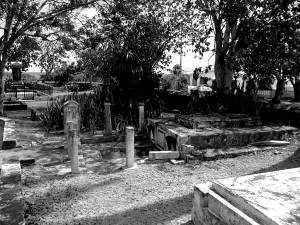 Selected Because: The Chase Tomb is mentioned in practically every ghost story book in print. To the passerby, it looks like just another monument, as dead and ancient as the rest of the colonial cemetery in which it lies. This vault however, is nothing but ordinary. It has been empty for more than 180 years, for no official reason. Although created for Mr. Elliot, he was never interred there. The vault was first used for the burial of a Mrs. Thomasina Goddard, whose coffin was placed inside on July 31, 1807. The Chase family purchased the vault a year later and soon after used the tomb to bury a Chase infant in 1808 and then an adult daughter, Dorcas in 1812, who was a probable suicide. Both individuals were buried in lead coffins. Nothing unusual inside the vault was reported during these two interments. The vault was resealed with the heavy marble slab that was cemented in placed, a practice performed on all subsequent interments. On August 8, 1812, the vault was opened for the burial of Thomas Chase himself. Astonishingly, the two previous interred lead coffins were found to be drastically moved from their original positions. The infant’s coffin was found standing on its head. The two coffins were placed back in their original side-by-side positions and the vault was re-sealed. In 1816, another burial took place this time for eleven year old Charles Brewster Ames. Again the coffins were everywhere but in their proper places. The 240 pound coffin of Thomas Chase which was so heavy, it took eight men to move, was also in the wrong location. After putting all the coffins back in place, the crypt was completely sealed. On November 17, 1816, the vault was opened again to accept the body of Samuel Brewster. This time, a large group of witnesses crowded the scene, looking to see if the mystery was to continue. The slab of marble which covered the door, was carefully examined. No breaks were found, and the vault was opened. Once again, the coffins were found to be in disarray throughout the vault. For the third time, the coffins were moved back to their original position and the vault sealed. On July 17, 1819, the vault was once again opened to admit the departed Thomasina Clark, and once again found to be in disorder. The only coffin untouched was the wooden, and fragile, one of the original Mrs. Goddard. This time the governor of the island, Lord Combermere ordered his own professional investigation. The entire vault was looked over, and nothing strange could be found. The coffins were re-stacked (Mrs. Goddard’s wooden coffin was stacked against a wall, since it was so frail) and very fine sand was placed on the floor to catch the footprints of their perpetrators. The vault was then re-closed and the personal seal of the governor was placed on the tomb. Everyone on the island awaited the next reopening. On April 18, 1820, some eight months after the burial of Thomasina Clark, the vault was ordered to be reopened. The seals were found to be intact, but when the marble slab was moved, the coffins, with the exception of Goddard’s wooden casket, were again found to be in disarray. The heaviest lead coffin of Thomas Chase was reported to be leaning against the inside of the vault door thus blocking any alleged perpetrator’s exit. The sand on the floor did not show any hint of human activity within the vault. There was also no indication of flooding or an earthquake. The governor ordered the coffins to be removed and buried elsewhere. The vault was left open and never used again.
Selected Because: The Chase Tomb is mentioned in practically every ghost story book in print. To the passerby, it looks like just another monument, as dead and ancient as the rest of the colonial cemetery in which it lies. This vault however, is nothing but ordinary. It has been empty for more than 180 years, for no official reason. Although created for Mr. Elliot, he was never interred there. The vault was first used for the burial of a Mrs. Thomasina Goddard, whose coffin was placed inside on July 31, 1807. The Chase family purchased the vault a year later and soon after used the tomb to bury a Chase infant in 1808 and then an adult daughter, Dorcas in 1812, who was a probable suicide. Both individuals were buried in lead coffins. Nothing unusual inside the vault was reported during these two interments. The vault was resealed with the heavy marble slab that was cemented in placed, a practice performed on all subsequent interments. On August 8, 1812, the vault was opened for the burial of Thomas Chase himself. Astonishingly, the two previous interred lead coffins were found to be drastically moved from their original positions. The infant’s coffin was found standing on its head. The two coffins were placed back in their original side-by-side positions and the vault was re-sealed. In 1816, another burial took place this time for eleven year old Charles Brewster Ames. Again the coffins were everywhere but in their proper places. The 240 pound coffin of Thomas Chase which was so heavy, it took eight men to move, was also in the wrong location. After putting all the coffins back in place, the crypt was completely sealed. On November 17, 1816, the vault was opened again to accept the body of Samuel Brewster. This time, a large group of witnesses crowded the scene, looking to see if the mystery was to continue. The slab of marble which covered the door, was carefully examined. No breaks were found, and the vault was opened. Once again, the coffins were found to be in disarray throughout the vault. For the third time, the coffins were moved back to their original position and the vault sealed. On July 17, 1819, the vault was once again opened to admit the departed Thomasina Clark, and once again found to be in disorder. The only coffin untouched was the wooden, and fragile, one of the original Mrs. Goddard. This time the governor of the island, Lord Combermere ordered his own professional investigation. The entire vault was looked over, and nothing strange could be found. The coffins were re-stacked (Mrs. Goddard’s wooden coffin was stacked against a wall, since it was so frail) and very fine sand was placed on the floor to catch the footprints of their perpetrators. The vault was then re-closed and the personal seal of the governor was placed on the tomb. Everyone on the island awaited the next reopening. On April 18, 1820, some eight months after the burial of Thomasina Clark, the vault was ordered to be reopened. The seals were found to be intact, but when the marble slab was moved, the coffins, with the exception of Goddard’s wooden casket, were again found to be in disarray. The heaviest lead coffin of Thomas Chase was reported to be leaning against the inside of the vault door thus blocking any alleged perpetrator’s exit. The sand on the floor did not show any hint of human activity within the vault. There was also no indication of flooding or an earthquake. The governor ordered the coffins to be removed and buried elsewhere. The vault was left open and never used again.
Location: London, England
History: The cemetery in its original form (the older Western part) was consecrated by the Bishop of London on the 20th of May 1839. It was part of an initiative to provide seven large, modern cemeteries to ring the city of London. The inner-city cemeteries, mostly the graveyards of individual churches, had long been unable to cope with the number of burials and were seen as a health hazard and an undignified way to treat the dead. Perched on a hill above the smoke and filth of the city, Highgate Cemetery soon became fashionable place for burials and was much admired and visited. The Victorian romantic attitude to death and its presentation led to the creation of a labyrinth of Egyptian sculptures and a slew of Gothic tombs and buildings. The rows of silent stone angels have bore witness to pomp and ceremony as well as to part of some dreadful exhumation. The avenues of death entombed poets, painters, princes and paupers.
Famous Occupants: Christina Rossetti, George Elliot, Raddclyffe Hall, the family of Charles Dickens and Karl Marx
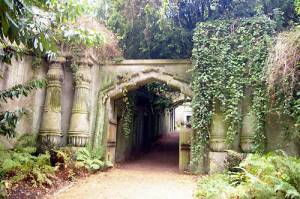 Selected Because: Among the artistic souls buried in the Western half of the graveyard is Elizabeth Siddal, mistress, muse and eventual wife of Pre-Raphaelite painter Dante Gabriel Rossetti. A hat makers assistant, beautiful Lizzie had been wooed by the dashing Italian immigrant, who refused to settle down after he had won her heart. Increasingly depressed after a stillborn child, Lizzie took her own life with an overdose of laudanum in 1862. At the graveside service, distraught Rossetti placed a handwritten volume of poems on her pillow just before the coffin lid was sealed. Rossetti’s fortune faltered after the death of his muse, and he became convinced that he was going blind and losing his painterly skills, and that he was destined to be remembered as a poet instead. His questionably scrupulous agent persuaded Rossetti that he could cement his reputation if only he’d publish the poems consigned to Lizzie’s grave. In October 1869, permissions was granted to exhume the coffin as long as it was done by night and did not upset the neighbours or patrons of the cemetery. By flickering torchlight, workmen peeled back the damp rich earth of England. This is perhaps where our story begins. When Lizzie’s coffin was forced open, all that remained of her beauty was the silken mass of her auburn mane. The grave robbers brushed tendrils of her hair from the silk bound manuscript, which was fumigated and eventually published. Lizzie’s remains were returned to the cold ground. The story was leaked, to Lloyd’s Weekly Newspaper. Elizabeth Miller in her book Dracula: Sense and Nonsense theorizes that Bram Stoker read the news while working on Dracula, since the paper also reviewed the Lyceum’s production of King Lear, with which Stoker was involved. If that is the case, Lizzie Siddal served in death as another man’s muse, transmuted as Lucy Westerna and given life beyond the grave. Whether Highgate Cemetery was the churchyard described by Stoker remains a matter of debate. In Dracula, Van Helsing says, “Lucy lies in the tomb of her kin, a lordly death-house in a lonely churchyard, away from teeming London, where the air is fresh and the sun rises over Hampstead Hill, and where wild flowers grow on their own accord”. These happenings certainly laid a solid foundation for the stories which began to circulate about Highgate being haunted. When it was finally suggested that a Vampire might be loose in the old cemetery, a veritable barrage of journalists, eager occultists and the just plain curious, swarmed around the decaying and grim mausoleums, garlic and crucifixes in hand. Other occurrences include terrifying creatures with glowing eyes, various ghosts, bells ringing in the disused chapel, a shrouded figure and a demented old woman with long grey hair who murdered her children in a fit of rage, to name just a few. (By far my favourite cemetery researched for this blog post).
Selected Because: Among the artistic souls buried in the Western half of the graveyard is Elizabeth Siddal, mistress, muse and eventual wife of Pre-Raphaelite painter Dante Gabriel Rossetti. A hat makers assistant, beautiful Lizzie had been wooed by the dashing Italian immigrant, who refused to settle down after he had won her heart. Increasingly depressed after a stillborn child, Lizzie took her own life with an overdose of laudanum in 1862. At the graveside service, distraught Rossetti placed a handwritten volume of poems on her pillow just before the coffin lid was sealed. Rossetti’s fortune faltered after the death of his muse, and he became convinced that he was going blind and losing his painterly skills, and that he was destined to be remembered as a poet instead. His questionably scrupulous agent persuaded Rossetti that he could cement his reputation if only he’d publish the poems consigned to Lizzie’s grave. In October 1869, permissions was granted to exhume the coffin as long as it was done by night and did not upset the neighbours or patrons of the cemetery. By flickering torchlight, workmen peeled back the damp rich earth of England. This is perhaps where our story begins. When Lizzie’s coffin was forced open, all that remained of her beauty was the silken mass of her auburn mane. The grave robbers brushed tendrils of her hair from the silk bound manuscript, which was fumigated and eventually published. Lizzie’s remains were returned to the cold ground. The story was leaked, to Lloyd’s Weekly Newspaper. Elizabeth Miller in her book Dracula: Sense and Nonsense theorizes that Bram Stoker read the news while working on Dracula, since the paper also reviewed the Lyceum’s production of King Lear, with which Stoker was involved. If that is the case, Lizzie Siddal served in death as another man’s muse, transmuted as Lucy Westerna and given life beyond the grave. Whether Highgate Cemetery was the churchyard described by Stoker remains a matter of debate. In Dracula, Van Helsing says, “Lucy lies in the tomb of her kin, a lordly death-house in a lonely churchyard, away from teeming London, where the air is fresh and the sun rises over Hampstead Hill, and where wild flowers grow on their own accord”. These happenings certainly laid a solid foundation for the stories which began to circulate about Highgate being haunted. When it was finally suggested that a Vampire might be loose in the old cemetery, a veritable barrage of journalists, eager occultists and the just plain curious, swarmed around the decaying and grim mausoleums, garlic and crucifixes in hand. Other occurrences include terrifying creatures with glowing eyes, various ghosts, bells ringing in the disused chapel, a shrouded figure and a demented old woman with long grey hair who murdered her children in a fit of rage, to name just a few. (By far my favourite cemetery researched for this blog post).
Location: Stull, Kansas
History: Stull Cemetery and the ruins of the abandoned church that rests next to it, are located in the tiny, nearly forgotten Kansas town of Stull. There is not much left of the tiny village, save for a few houses and maybe 20 residents. Although there are literally dozens of stories of hauntings and folklore the only two factual and written recordings of tragedy in Stull are as follows. A young boy was incinerated in a pasture beside the cemetery when his father had burned the field to generate better crop growth the following year. And a man was reported missing one night, only to be found hanging from a tree by the old church in Stull Cemetery.
Famous Occupants: None
- The Devil chooses two places to appear on Earth on Halloween. One is Stull Kansas, the other is some place on the desolate plains of India.
- Satan gathers all the people who died violent deaths over the past year and they dance around the Earth at witching hour.
- An old wooden crucifix hanging in the old church would turn upside down when an unfamiliar person would step into the church.
- Pope John II instructed his plane to fly around Kansas so he would not fly over “unholy” ground on his last visit to the United States
- Visitors to the cemetery have been grabbed, experienced memory loss, strong winds holding them motionless, and loosing time.
- When the old church was still standing, although one wall was gone and the roof had been destroyed for years, rain never fell on the church floor
- The Devil visits the graveyard on the last day of winter or the first day of Spring to visit a witch that is buried there. A tombstone bearing the name “Wittich” is located close to the where the old church stood.
- An old tree in the cemetery was once used as a gallows for condemned witches
- A grave in the cemetery is reported to hold the bones of “a child of Satan”, born of the Devil and a witch. The child was so deformed it only lived a few days, but the body was buried at Stull.
- A stairway to hell is either located in or beside the church. On March 29, 2002 (Good Friday), the old brick church came tumbling down. Thus closing the “portal to hell”. No one gave the order to have it destroyed, it just mysteriously collapsed.
- In Stull, Chuck Norris sold his soul to the Devil for his rugged good looks and unparalleled martial arts abilities. Shortly after the transaction was finalized, Chuck beat the Devil up and took his soul back. The Devil, who appreciated irony couldn’t stay mad and admitted that he should have seen it coming. They now play poker every second Wednesday of the month at Stull.
Location: New Orleans, Louisiana
History: This place, built-in 1789, is New Orleans oldest cemetery, a grand European mixture of ornate marble tombs, crumbling memorials and narrow winding footpaths. In 1975, it was listed in the National Register of Historic Places, endured major restoration efforts in 2004, and today is considered one of the most haunted places in the world. New Orleans is unique in that the city is below sea level. This uniqueness makes it nearly impossible to bury the dead in the ground, so the dead are buried in vaults and mausoleums. Do to the lack of land, and having to bury their dead above ground, New Orleans invented another way to deal with its space restrictions. Family members are placed in a wooden coffin, and buried in a vault for a year plus a day. After that time frame, the coffin is removed and the deceased are put into a bag. The bag is then labelled and pushed to the back of the vault, leaving room for the next body. Though Cemetery #1 is only one square block in diameter it is the resting place of more then 100,000 souls.
Famous Occupants: The family tomb of Etienne de Bore (Kings Musketeer turned sugar entrepreneur and mayor of New Orleans), Marie Laveau (Voodoo Priestess), Ernest Dutch Morial
 Selected Because: In a small place, where so many souls have been laid to rest, and so many have been disrupted from their resting place, it is not hard to believe that this cemetery is considered one of the most haunted in the world. Visitors have heard weeping and groaning from inside the crypts, while others have seen a range of spectral phenomena from unusual mists to full-fledged transparent figures. One ghost had dominated above all other though, and that is the ghost of Marie Laveau the Voodoo Queen of New Orleans. Although the truth about her life is obscured by folklore, there most definitely was a Maria Laveau, Voodoo Priestess. Whether she really did live to be over 100 years old while retaining the lithe, sensual body of a young woman, is open to debate, but the Queen did leave her mark on the culture of New Orleans. Born a free Creole woman, she became a hairdresser to the upper class. She began to practice Voodoo and soon garnered a huge following. Marie Laveau died in 1881, but even today many believers leave offering at her grave in hope that she will bless the from the other side. Many believe that death never stopped her from practicing her black magic or from using the powers of darkness. Some say she turns herself into a black crow or dog, both such animals have been seen wandering the cemetery. Others have seen here stomping around her grave, never happy and often shouting curses.
Selected Because: In a small place, where so many souls have been laid to rest, and so many have been disrupted from their resting place, it is not hard to believe that this cemetery is considered one of the most haunted in the world. Visitors have heard weeping and groaning from inside the crypts, while others have seen a range of spectral phenomena from unusual mists to full-fledged transparent figures. One ghost had dominated above all other though, and that is the ghost of Marie Laveau the Voodoo Queen of New Orleans. Although the truth about her life is obscured by folklore, there most definitely was a Maria Laveau, Voodoo Priestess. Whether she really did live to be over 100 years old while retaining the lithe, sensual body of a young woman, is open to debate, but the Queen did leave her mark on the culture of New Orleans. Born a free Creole woman, she became a hairdresser to the upper class. She began to practice Voodoo and soon garnered a huge following. Marie Laveau died in 1881, but even today many believers leave offering at her grave in hope that she will bless the from the other side. Many believe that death never stopped her from practicing her black magic or from using the powers of darkness. Some say she turns herself into a black crow or dog, both such animals have been seen wandering the cemetery. Others have seen here stomping around her grave, never happy and often shouting curses.
Location: Palermo, Sicily
History: The Capuchin Order is an offshoot of the more famous Franciscans that branched out in the mid sixteenth century. Their name comes from the distinctive hood that the monks wore that has since lent its name to the popular coffee drink Cappuccino, whose foamed milk top it resembles. Even though this Order of the Friars Minor originated in the Marché region of Italy, their unique take on the mortal body after death made them a perfect fit for Sicily. In fact the first monk to be embalmed was placed in the crypt shortly after the Order arrived in Palermo. Approximately 8,000 corpses dating from the 1500’s to 1920 are housed within the Catacombs. In the early 16th century, the church originally meant to preserve and make accessible the bodies of monks and friars in order to be able to ask for their intercessions face to face. The trend caught on, and soon the general population also wanted to be preserved and buried in the catacombs so that their families could visit them.
Famous Occupants: Rosalia Lombard, Brother Silvestro Gubbió, Colonel Enea Di Guiliano
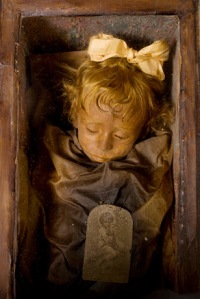 Selected Because: It has been said that Sicilian’s have an obsession with death. It is still very common to see elderly Sicilian widows wearing black for the remainder of their lives and an occupation of professional mourners once existed for centuries. It is hard to say where this cult of the dead comes from, either from the deep-rooted Catholic faith, or perhaps a hold over from ancient Greek and Roman times. Regardless of the origins, nothing exemplifies this better than Capuchin Crypt. As you walk down the steps into the crypt it feels as though there should be a reminder of Dante’s warning written above the gates of hell “Abandon All Hope, Ye Who Enter Here”. Once inside, the crypt looks more like the set for “Night of the Living Dead” or Michael Jackson’s “Thriller”, then a religious community. No horror movie, or amusement park can compete with the hundreds of bodies dressed in their Sunday’s best and suspended by hooks in the walls. The bodies, in various levels if decay stare down at you (some with their own eyes) looking as though they are ready to grab you or wanting you to join them. People have been known to quickly become overwhelmed and have to stop or leave the crypts. Voices have been heard whispering in the dark corners. And at the very end of the tomb in the last viewing room lays the body of the last person interred in the crypt. Rosalia Lombard, a three-year old who has been so perfectly preserved in her glass coffin that it looks as though she is only asleep. It is hard to believe that she has been dead for 90 plus years and while looking at her you expect her to sit up and say hello. A small child’s voice has often been heard singing in this room or tiny footsteps running through the vault.
Selected Because: It has been said that Sicilian’s have an obsession with death. It is still very common to see elderly Sicilian widows wearing black for the remainder of their lives and an occupation of professional mourners once existed for centuries. It is hard to say where this cult of the dead comes from, either from the deep-rooted Catholic faith, or perhaps a hold over from ancient Greek and Roman times. Regardless of the origins, nothing exemplifies this better than Capuchin Crypt. As you walk down the steps into the crypt it feels as though there should be a reminder of Dante’s warning written above the gates of hell “Abandon All Hope, Ye Who Enter Here”. Once inside, the crypt looks more like the set for “Night of the Living Dead” or Michael Jackson’s “Thriller”, then a religious community. No horror movie, or amusement park can compete with the hundreds of bodies dressed in their Sunday’s best and suspended by hooks in the walls. The bodies, in various levels if decay stare down at you (some with their own eyes) looking as though they are ready to grab you or wanting you to join them. People have been known to quickly become overwhelmed and have to stop or leave the crypts. Voices have been heard whispering in the dark corners. And at the very end of the tomb in the last viewing room lays the body of the last person interred in the crypt. Rosalia Lombard, a three-year old who has been so perfectly preserved in her glass coffin that it looks as though she is only asleep. It is hard to believe that she has been dead for 90 plus years and while looking at her you expect her to sit up and say hello. A small child’s voice has often been heard singing in this room or tiny footsteps running through the vault.
Location: Edinburgh, Scotland
History: The Greyfriar’s Kirkyard is a 12th century cemetery nestled between an old 16th century prison that was expanded through the 19th century on one side, and an old hospital on the other. The hospital was at one time an infirmary used for tuberculosis and served as a home for the mentally insane. The courtyard is often quiet and pleasant for walking through, and off in the distance is a spectacular view of Edinburgh Castle and St. Gilles Cathedral. The prison was known as Covenanter’s Prison. There were over 1,200 Covenanters imprisoned at any given time from the 17th century to the 19th century. On a hot summer day it was said that because of the repulsive conditions at the prison including; lack of hygiene, neglect and filth, the stench of the prison would permeate the air.
 Famous Occupants: Mary Queen of Scots granted the area surrounding Greyfriar’s to be used as a burial ground in 1562 for its congregation. There are many famous Scots that are said to be buried here. Sir Walter Scott’s father, William McGonnegal (Scotland’s worst poet), George Herriot, James Craig(architect), and William Adam.
Famous Occupants: Mary Queen of Scots granted the area surrounding Greyfriar’s to be used as a burial ground in 1562 for its congregation. There are many famous Scots that are said to be buried here. Sir Walter Scott’s father, William McGonnegal (Scotland’s worst poet), George Herriot, James Craig(architect), and William Adam.
Selected Because: This small cemetery has been considered haunted for centuries, and more recently has been listed as one of the ‘most dangerous’ places in the world to visit. Its gruesome past includes witchcraft, body snatching, headstone removal, desecration, corpse dumping and live burials. Probably the most famous resident of Greyfriar’s is Bobby, a loyal Skye Terrier owned by John Gray. Bobby was so loyal to his master that when John Gray died of tuberculosis on February 15, 1858 it was said that Bobby kept a daily vigil over his masters grave until his own death on the 14th of January 1872, 14 years later. The dog was buried in an unmarked grave within Greyfriar’s Kirkland, and today there is still a daily one o’clock bell that rings to commemorate the hour at which locals would feed Bobby.  There are many reports of hearing Bobby barking within the walls of the cemetery. Towards the back of the cemetery in an area called “The Black Mausoleum”, where a much more malevolent entity can be found. Commonly called the MacKenzie Poltergeist, the actual identity of the spirit is up for debate. Some believe it is a genuine poltergeist, not the ghost of any particular person, but rather a manifestation of the psychic trauma generated in 1679 when more than 1,000 Covenanters (Scots who declared themselves Presbyterian at a time when Episcopalian was the only sanctioned religion), were imprisoned here without food and water and allowed to slowly starve to death as they awaited trial. Others think it is the spirit of George MacKenzie who died in 1691 and was interred in what has become known as “The Black Mausoleum”. MacKenzie was infamous for his brutal persecution of the Covenanters. In 1998 something began occurring in the graveyard. Visitors started encountering cold spots, smells and loud banging noises. Many became suddenly overwhelmed by nausea and left with cuts and bruises by something that was not visible. During the next two years, twenty-nine people were knocked unconscious that ventured into the prison through the cemetery gates. The homes that are next to the graveyard also became plagued with unexplained events inside them. Objects inside the homes had been smashed against the wall or moved themselves. An unexplained and unidentified laughter was also frequently heard. The section of Greyfriar’s where the attacks occurred is now chained shut and the general public is not granted admission.
There are many reports of hearing Bobby barking within the walls of the cemetery. Towards the back of the cemetery in an area called “The Black Mausoleum”, where a much more malevolent entity can be found. Commonly called the MacKenzie Poltergeist, the actual identity of the spirit is up for debate. Some believe it is a genuine poltergeist, not the ghost of any particular person, but rather a manifestation of the psychic trauma generated in 1679 when more than 1,000 Covenanters (Scots who declared themselves Presbyterian at a time when Episcopalian was the only sanctioned religion), were imprisoned here without food and water and allowed to slowly starve to death as they awaited trial. Others think it is the spirit of George MacKenzie who died in 1691 and was interred in what has become known as “The Black Mausoleum”. MacKenzie was infamous for his brutal persecution of the Covenanters. In 1998 something began occurring in the graveyard. Visitors started encountering cold spots, smells and loud banging noises. Many became suddenly overwhelmed by nausea and left with cuts and bruises by something that was not visible. During the next two years, twenty-nine people were knocked unconscious that ventured into the prison through the cemetery gates. The homes that are next to the graveyard also became plagued with unexplained events inside them. Objects inside the homes had been smashed against the wall or moved themselves. An unexplained and unidentified laughter was also frequently heard. The section of Greyfriar’s where the attacks occurred is now chained shut and the general public is not granted admission.
About the pics: If you see pics that belong to you, don’t get your knickers in a knot. Please let me know and I will either remove them, or apply credit and a link to your site. Your choice. Merci.
Leave a comment
No comments yet.






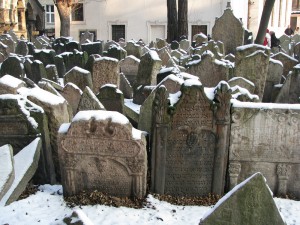
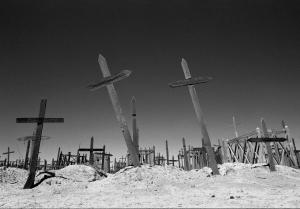
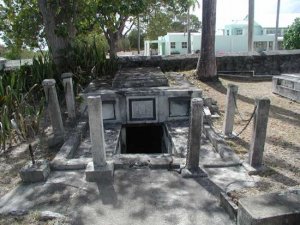
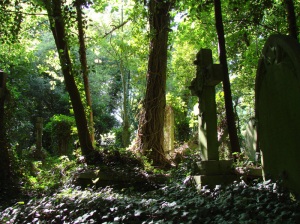
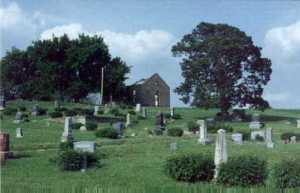
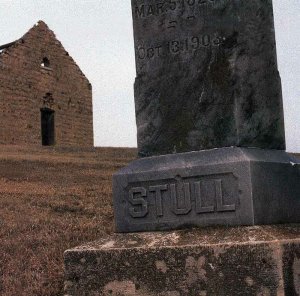
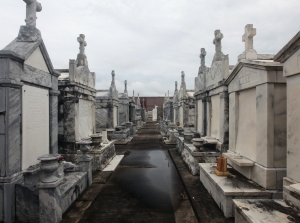
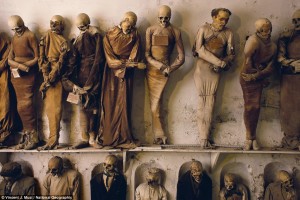
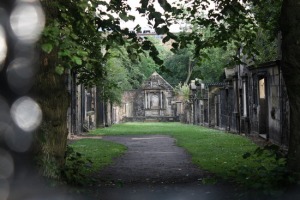
Leave a comment